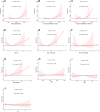The effect of metabolic syndrome on head and neck cancer incidence risk: a population-based prospective cohort study
- PMID: 34082811
- PMCID: PMC8173864
- DOI: 10.1186/s40170-021-00261-w
The effect of metabolic syndrome on head and neck cancer incidence risk: a population-based prospective cohort study
Abstract
Background: There are limited evidences clarifying the impact of metabolic syndrome (MS) and its components on head and neck cancer (HNC) incidence risk. We explored the correlation between MS, MS components, and the combined effects of MS and C-reactive protein (CRP) and HNC risk.
Methods: This is a prospective analysis of 474,929 participants from the UK Biobank cohort. Cox proportional hazard regression was utilized to assess the hazard ratio (HR) and 95% confidence interval (CI) and to explore the non-linear correlation between an individual MS component and HNC risk.
Results: Individuals with MS (HR, 1.05; 95%CI, 0.90-1.22) had no higher HNC risk than those without MS. More MS components showed no higher HNC risk. Nevertheless, hyperglycemia (HR, 1.22; 95%CI, 1.02-1.45) was independently correlated with elevated HNC risk. In a non-linear manner, waist circumference and high-density lipoprotein cholesterol (HDL-C) showed a U-shaped association with HNC risk. Further, piecewise linear model analysis indicated that higher male waist circumference, female waist circumference (≥93.16 cm), blood glucose (≥4.70 mmol/L) and male HDL-C (≥1.26mmo/L), and lower male HDL-C (<1.26mmo/L) were correlated with higher HNC risk. Increased CRP (≥1.00mg/dL) elevated HNC risk and individuals with MS and CRP≥1.00mg/dL had the highest HNC risk (HR, 1.29; 95%CI, 1.05-1.58). But no joint effect between MS and CRP was detected (p-interaction=0.501).
Conclusions: MS are not correlated with elevated HNC risk. High waist circumference and blood glucose are independent risk factor of HNC incidence. Controlling HDL-C in an appropriate range can get the lowest risk of male HNC. No joint effect of MS and CRP exists in HNC tumorigenesis.
Keywords: C-reactive protein; Head and neck cancer; Metabolic syndrome; Metabolic syndrome components.
Conflict of interest statement
The authors declare that they have no competing interests.
Figures

References
Grants and funding
LinkOut - more resources
Full Text Sources
Research Materials
Miscellaneous

